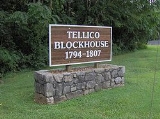
Tellico Blockhouse
Encyclopedia
The Tellico Blockhouse was an early American outpost located along the Little Tennessee River
in Vonore
, Monroe County, Tennessee. Completed in 1794, the blockhouse
operated until 1807 with the purpose of keeping the peace between nearby Overhill Cherokee
towns and early Euro-American settlers in the area in the wake of the Chickamauga Wars
. The Tellico Blockhouse was the site where several treaties were negotiated in which the Cherokee
were induced to cede large portions of land in Tennessee
and Georgia
. During this period, the blockhouse was the site of official liaisons between the United States government and the Cherokee (and, eventually, the Chickamauga
).
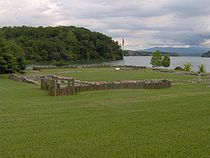 The Tellico Blockhouse site is located at the junction of Nine Mile Creek and the Little Tennessee River (now Tellico Lake), just off U.S. Route 411
The Tellico Blockhouse site is located at the junction of Nine Mile Creek and the Little Tennessee River (now Tellico Lake), just off U.S. Route 411
between Maryville
and Vonore
. Fort Loudoun
was located just across the river to the west, but was in ruins by the time the blockhouse was built.
Although the Tellico Blockhouse originally stood on a high bluff overlooking the Little Tennessee valley, the impoundment of the river by Tellico Dam in 1979 pushed the river's present shoreline to within a few meters of the blockhouse site. The Overhill towns of Chota
and Great Tellico
were within a day's journey to the south. The river town of Morganton
(then known as "Portville") was within walking distance, and Knoxville
was just over thirty miles downstream to the north. As there were no bridges spanning the Little Tennessee until the late 19th century, blockhouse officials crossed at Niles Ferry, which was located at the modern US-411 bridge.
The Tellico Blockhouse was the starting point for the Old Federal Road
, which connected Knoxville to Cherokee settlements in Georgia.
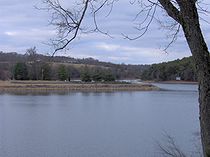 The second half of the 18th century saw a rapid expansion of European settlers into East Tennessee
The second half of the 18th century saw a rapid expansion of European settlers into East Tennessee
. This invariably brought them into conflict with the Cherokee, who had lived and hunted in the land for centuries. Random murders and scalpings became commonplace, and the settlers formed independent militias to carry out reprisal attacks. This violence reached a climax in 1793, when the Cherokee attacked Henry's Station in Blount County
, and the settlers responded by crossing Chilhowee Mountain
and sacking the Cherokee village of Tallassee
. Even as the Cherokee chief Hanging Maw
was meeting with Governor William Blount
to discuss bringing peace to the area, the chief's delegation was attacked by a band of settlers, killing several Cherokee headmen.
With the violence spiraling out of control, Hanging Maw convinced Blount to construct a fort in the vicinity of the Overhill towns. The chief even donated the land. The Tellico Blockhouse was completed and garrisoned by federal troops from Knoxville in 1794. John McKee, a surveyor in the area, was appointed the first Tellico Agent. The agent would be the official liaison between the United States government and the Cherokee Nation.
The blockhouse itself was a crude fort that utilized earthworks and timber. Sawed planking was shipped upstream from Knoxville. Historian J. G. M. Ramsey
gives the following description:
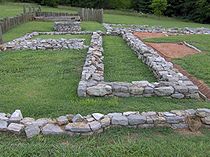 The original blockhouse was approximately 120x100 feet, enclosed by a palisade approximately 16 feet high. The gate was on the north wall, with the captain's quarters and guardhouse just inside the gate. The original enclosure also contained two barracks, a well, and parade grounds. A watchtower stood at the northeast corner.
The original blockhouse was approximately 120x100 feet, enclosed by a palisade approximately 16 feet high. The gate was on the north wall, with the captain's quarters and guardhouse just inside the gate. The original enclosure also contained two barracks, a well, and parade grounds. A watchtower stood at the northeast corner.
In 1795, Congress
passed the Factory Act, which sought to improve relations with American Indians by setting up official trading posts and teaching the natives agricultural and mechanical techniques. To implement this, McKee's successor, Silas Dinsmoor, expanded the Tellico Blockhouse to nearly double its original size to incorporate a civilian half. This new section, separated by a wall from the military section, contained lodging areas for travelers and delegates and a two-story building known as the Tellico Factory. Along with a trading post where European-American tools and finished goods were traded for Native American furs and raw materials, the factory included a section where members of the new Cherokee Nation
could learn mechanical arts and spinning and weaving cloth.
In 1797, one of the first recorded Christmas
celebrations in Tennessee occurred at the Tellico Blockhouse when the Little Tennessee River froze over. On the night of December 25, Dinsmoor and the federal garrison held a dinner party on the ice, later documented by Ramsey:
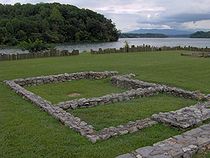 The Tellico Blockhouse probably reached the height of its activity around 1799, due to its situation along the Old Federal Road. That same year, Louis-Philippe
The Tellico Blockhouse probably reached the height of its activity around 1799, due to its situation along the Old Federal Road. That same year, Louis-Philippe
, Duke of Orleans and later king of France, paid a visit to the blockhouse. In 1800, several Cherokee leaders convened at the blockhouse to debate whether or not to allow missionaries into the Cherokee towns. The Cherokees hoped the missionaries would provide educational services to their children.
In the early 19th century, the encroachment of settlers slowly drove the Cherokee south to the Hiwassee River and on to Georgia. As the Overhill towns along the Little Tennessee River began to disperse, the Tellico Blockhouse's influence started to wane. In 1801, Colonel Return J. Meigs
took over as Cherokee agent, an appointment which effectively moved the agency to Fort Southwest Point
(modern Kingston, Tennessee
), where Meigs was based. In 1805, the last Tellico treaty called for the removal of the blockhouse garrison south to the Hiwassee River area.
Archaeologists from the University of Tennessee
conducted excavations at the Tellico Blockhouse site in the 1970s, and located the fort's foundations and a number of artifacts. Due to a lack of records, officials were unable to attempt a reconstruction of the blockhouse, but managed to reinforce the foundations with authentic fill material so visitors to the site can see the fort's layout. Short posts were erected to show the position of the blockhouse walls, and interpretive signs were placed at the site to explain the fort's brief history. The site is currently managed by the Fort Loudoun State Historic Area. Some of the artifacts recovered during the excavation are on display at the Frank H. McClung Museum
in Knoxville.
Little Tennessee River
The Little Tennessee River is a tributary of the Tennessee River, approximately 135 miles long, in the Appalachian Mountains in the southeastern United States.-Geography:...
in Vonore
Vonore, Tennessee
Vonore is a town in Blount and Monroe counties in the U.S. state of Tennessee. The population was 1,162 as of the 2000 census.-Geography:Vonore is located at ....
, Monroe County, Tennessee. Completed in 1794, the blockhouse
Blockhouse
In military science, a blockhouse is a small, isolated fort in the form of a single building. It serves as a defensive strong point against any enemy that does not possess siege equipment or, in modern times, artillery...
operated until 1807 with the purpose of keeping the peace between nearby Overhill Cherokee
Overhill Cherokee
The term Overhill Cherokee refers to the former Cherokee settlements located in what is now Tennessee in the southeastern United States. The name was given by 18th century European traders and explorers who had to cross the Appalachian Mountains to reach these settlements when traveling from...
towns and early Euro-American settlers in the area in the wake of the Chickamauga Wars
Chickamauga wars
The Chickamauga Wars were a series of raids, campaigns, ambushes, minor skirmishes, and several full-scale frontier battles which were a continuation of the Cherokee struggle against encroachment by American frontiersmen from the former British colonies...
. The Tellico Blockhouse was the site where several treaties were negotiated in which the Cherokee
Cherokee
The Cherokee are a Native American people historically settled in the Southeastern United States . Linguistically, they are part of the Iroquoian language family...
were induced to cede large portions of land in Tennessee
Tennessee
Tennessee is a U.S. state located in the Southeastern United States. It has a population of 6,346,105, making it the nation's 17th-largest state by population, and covers , making it the 36th-largest by total land area...
and Georgia
Georgia (U.S. state)
Georgia is a state located in the southeastern United States. It was established in 1732, the last of the original Thirteen Colonies. The state is named after King George II of Great Britain. Georgia was the fourth state to ratify the United States Constitution, on January 2, 1788...
. During this period, the blockhouse was the site of official liaisons between the United States government and the Cherokee (and, eventually, the Chickamauga
Chickamauga Indian
The Chickamauga or Lower Cherokee, were a band of Cherokee who supported Great Britain at the outbreak of the American Revolutionary War. They were followers of the Cherokee chief Dragging Canoe...
).
Geographic setting

U.S. Route 411
U.S. Highway 411 is an alternate parallel-highway associated with U.S. Highway 11. U.S. 411 extends for about 313 miles from U.S. Route 78 in Leeds, Jefferson County, Alabama, to U.S. Highway 25 in Newport, Cocke County, Tennessee. U.S. 411 passes through the northeastern State of Alabama, the...
between Maryville
Maryville, Tennessee
Maryville is the county seat of Blount County, Tennessee, in the Southeastern United States. The city is located south of Knoxville. Maryville's population was 27,258 at the 2010 census. It is included in the Knoxville Metropolitan Area. Maryville has received a number of accolades for its...
and Vonore
Vonore, Tennessee
Vonore is a town in Blount and Monroe counties in the U.S. state of Tennessee. The population was 1,162 as of the 2000 census.-Geography:Vonore is located at ....
. Fort Loudoun
Fort Loudoun (Tennessee)
Fort Loudoun was a British colonial fort in present-day Monroe County, Tennessee, near the towns of the Overhill Cherokee. The fort was reconstructed during the Great Depression and was designated a National Historic Landmark in 1965.-History:...
was located just across the river to the west, but was in ruins by the time the blockhouse was built.
Although the Tellico Blockhouse originally stood on a high bluff overlooking the Little Tennessee valley, the impoundment of the river by Tellico Dam in 1979 pushed the river's present shoreline to within a few meters of the blockhouse site. The Overhill towns of Chota
Chota (Cherokee town)
Chota is a historic Overhill Cherokee site in Monroe County, Tennessee, in the southeastern United States. For much of its history, Chota was the most important of the Overhill towns, serving as the de facto capital of the Cherokee people from the late 1740s until 1788...
and Great Tellico
Great Tellico
Great Tellico was a Cherokee town at the site of present-day Tellico Plains, Tennessee, where the Tellico River emerges from the Appalachian Mountains. Great Tellico was one of the largest Cherokee towns in the region, and had a sister town nearby named Chatuga. Its name in Cherokee is more...
were within a day's journey to the south. The river town of Morganton
Morganton, Tennessee
Morganton was a community once located in Loudon County, Tennessee, in the southeastern United States. Although now submerged by Tellico Lake, during its heyday in the 19th century Morganton thrived as a flatboat port and regional business center...
(then known as "Portville") was within walking distance, and Knoxville
Knoxville, Tennessee
Founded in 1786, Knoxville is the third-largest city in the U.S. state of Tennessee, U.S.A., behind Memphis and Nashville, and is the county seat of Knox County. It is the largest city in East Tennessee, and the second-largest city in the Appalachia region...
was just over thirty miles downstream to the north. As there were no bridges spanning the Little Tennessee until the late 19th century, blockhouse officials crossed at Niles Ferry, which was located at the modern US-411 bridge.
The Tellico Blockhouse was the starting point for the Old Federal Road
Federal Road (Cherokee lands)
The Federal Road, originally called Georgia Road, was a federal toll highway passing through the Cherokee Nation in the northern part of the U.S. state of Georgia. From 1805 to the 1840s, the road linked Savannah, Georgia with Knoxville, Tennessee...
, which connected Knoxville to Cherokee settlements in Georgia.
History

East Tennessee
East Tennessee is a name given to approximately the eastern third of the U.S. state of Tennessee, one of the three Grand Divisions of Tennessee defined in state law. East Tennessee consists of 33 counties, 30 located within the Eastern Time Zone and three counties in the Central Time Zone, namely...
. This invariably brought them into conflict with the Cherokee, who had lived and hunted in the land for centuries. Random murders and scalpings became commonplace, and the settlers formed independent militias to carry out reprisal attacks. This violence reached a climax in 1793, when the Cherokee attacked Henry's Station in Blount County
Blount County, Tennessee
Blount County is a U.S. county located in the U.S. state of Tennessee. Its population was 123,010 at the United States Census, 2010. The county seat is at Maryville, which is also the county's largest city....
, and the settlers responded by crossing Chilhowee Mountain
Chilhowee Mountain
Chilhowee Mountain is a low ridge at the outer edge of the Great Smoky Mountains that stretches between the Little Tennessee River to the west and the Little Pigeon River watershed to the east...
and sacking the Cherokee village of Tallassee
Tallassee (Cherokee town)
Tallassee is a prehistoric and historic Native American site in Blount County and Monroe County, Tennessee, in the southeastern United States. Tallassee was the southernmost of a string of Overhill Cherokee villages that spanned the lower Little Tennessee River in the 18th century...
. Even as the Cherokee chief Hanging Maw
Hanging Maw
Hanging Maw, or Uskwa'li-gu'ta in Cherokee, was the leading chief of the Overhill Cherokee from 1788 to 1794. They were located in present-day Tennessee...
was meeting with Governor William Blount
William Blount
William Blount, was a United States statesman. He was a delegate to the Constitutional Convention for North Carolina, the first and only governor of the Southwest Territory, and Democratic-Republican Senator from Tennessee . He played a major role in establishing the state of Tennessee. He was the...
to discuss bringing peace to the area, the chief's delegation was attacked by a band of settlers, killing several Cherokee headmen.
With the violence spiraling out of control, Hanging Maw convinced Blount to construct a fort in the vicinity of the Overhill towns. The chief even donated the land. The Tellico Blockhouse was completed and garrisoned by federal troops from Knoxville in 1794. John McKee, a surveyor in the area, was appointed the first Tellico Agent. The agent would be the official liaison between the United States government and the Cherokee Nation.
The blockhouse itself was a crude fort that utilized earthworks and timber. Sawed planking was shipped upstream from Knoxville. Historian J. G. M. Ramsey
J. G. M. Ramsey
James Gettys McGready Ramsey was an American historian, physician, and businessman, active primarily in East Tennessee during the nineteenth century. Ramsey is perhaps best known for his book, The Annals of Tennessee, a seminal work documenting the state's frontier and early statehood periods...
gives the following description:
...a strong work, of considerable size, with a projection on each square, furnished with port-holes, and calculated to stand a siege by an enemy provided with small arms only.

In 1795, Congress
United States Congress
The United States Congress is the bicameral legislature of the federal government of the United States, consisting of the Senate and the House of Representatives. The Congress meets in the United States Capitol in Washington, D.C....
passed the Factory Act, which sought to improve relations with American Indians by setting up official trading posts and teaching the natives agricultural and mechanical techniques. To implement this, McKee's successor, Silas Dinsmoor, expanded the Tellico Blockhouse to nearly double its original size to incorporate a civilian half. This new section, separated by a wall from the military section, contained lodging areas for travelers and delegates and a two-story building known as the Tellico Factory. Along with a trading post where European-American tools and finished goods were traded for Native American furs and raw materials, the factory included a section where members of the new Cherokee Nation
Cherokee Nation (19th century)
The Cherokee Nation of the 19th century —an historic entity —was a legal, autonomous, tribal government in North America existing from 1794–1906. Often referred to simply as The Nation by its inhabitants, it should not be confused with what is known today as the "modern" Cherokee Nation...
could learn mechanical arts and spinning and weaving cloth.
In 1797, one of the first recorded Christmas
Christmas
Christmas or Christmas Day is an annual holiday generally celebrated on December 25 by billions of people around the world. It is a Christian feast that commemorates the birth of Jesus Christ, liturgically closing the Advent season and initiating the season of Christmastide, which lasts twelve days...
celebrations in Tennessee occurred at the Tellico Blockhouse when the Little Tennessee River froze over. On the night of December 25, Dinsmoor and the federal garrison held a dinner party on the ice, later documented by Ramsey:
On the 25th, a Christmas dinner was given upon the ice, by the Federal officers,
at Tellico Block-house, to a large company of gentlemen and ladies. "Contiguous to the place of entertainment, two quarters of a bear were barbecued, where the ice was found to be, in thickness, sufficient to bare fire enough to have roasted an ox, without being materially weakened by the heat."

Louis-Philippe of France
Louis Philippe I was King of the French from 1830 to 1848 in what was known as the July Monarchy. His father was a duke who supported the French Revolution but was nevertheless guillotined. Louis Philippe fled France as a young man and spent 21 years in exile, including considerable time in the...
, Duke of Orleans and later king of France, paid a visit to the blockhouse. In 1800, several Cherokee leaders convened at the blockhouse to debate whether or not to allow missionaries into the Cherokee towns. The Cherokees hoped the missionaries would provide educational services to their children.
In the early 19th century, the encroachment of settlers slowly drove the Cherokee south to the Hiwassee River and on to Georgia. As the Overhill towns along the Little Tennessee River began to disperse, the Tellico Blockhouse's influence started to wane. In 1801, Colonel Return J. Meigs
Return J. Meigs, Sr.
Return Jonathan Meigs [born December 17 or December 28 , 1740; died January 28, 1823] was a colonel who served in the Continental Army during the American Revolutionary War, was one of the founding settlers of the Northwest Territory in what is now the state of Ohio, and later served as a federal...
took over as Cherokee agent, an appointment which effectively moved the agency to Fort Southwest Point
Fort Southwest Point
Fort Southwest Point was a federal frontier outpost at what is now Kingston, Tennessee, in the southeastern United States. Constructed in 1797 and garrisoned by federal soldiers until 1811, the fort served as a major point of interaction between the Cherokee and the United States government as...
(modern Kingston, Tennessee
Kingston, Tennessee
Kingston is a city in and the county seat of Roane County, Tennessee, United States, and is adjacent to Watts Bar Lake. Kingston, with a population of 5,264 at the 2000 United States census, is included in the Harriman, Tennessee Micropolitan Statistical Area....
), where Meigs was based. In 1805, the last Tellico treaty called for the removal of the blockhouse garrison south to the Hiwassee River area.
Archaeologists from the University of Tennessee
University of Tennessee
The University of Tennessee is a public land-grant university headquartered at Knoxville, Tennessee, United States...
conducted excavations at the Tellico Blockhouse site in the 1970s, and located the fort's foundations and a number of artifacts. Due to a lack of records, officials were unable to attempt a reconstruction of the blockhouse, but managed to reinforce the foundations with authentic fill material so visitors to the site can see the fort's layout. Short posts were erected to show the position of the blockhouse walls, and interpretive signs were placed at the site to explain the fort's brief history. The site is currently managed by the Fort Loudoun State Historic Area. Some of the artifacts recovered during the excavation are on display at the Frank H. McClung Museum
Frank H. McClung Museum
The Frank H. McClung Museum is a general museum located on the campus of the University of Tennessee in Knoxville. Built in 1963, exhibits focus on natural history, archeology, anthropology, decorative arts, and local history...
in Knoxville.
Treaties
Several treaties between the United States and the Cherokee Nation were negotiated at the Tellico Blockhouse:- A treaty signed on November 8, 1794 brought an end to the Chickamauga WarsChickamauga warsThe Chickamauga Wars were a series of raids, campaigns, ambushes, minor skirmishes, and several full-scale frontier battles which were a continuation of the Cherokee struggle against encroachment by American frontiersmen from the former British colonies...
. Cherokee chiefs Hanging Maw (representing the Upper Cherokee) and Colonel John Watt (representing the Lower Cherokee, or "Chickamauga") met with Governor William Blount to negotiate an end to the violence. All sides agreed to recognize boundaries set forth in previous treaties. - The First Treaty of Tellico, also known as the Treaty with the Cherokee, negotiated in 1797 and signed on October 2, 1798, aimed to resolve differences brought about by the attempts of the U.S. Congress to force illegal settlers ("squatters") from Cherokee lands. In exchange for ceding land to the settlers, the Cherokee received various financial incentives and a guarantee of the right of the Cherokee Nation to "exist forever." The U.S. negotiators, acting on instructions from Governor John SevierJohn SevierJohn Sevier served four years as the only governor of the State of Franklin and twelve years as Governor of Tennessee. As a U.S. Representative from Tennessee from 1811 until his death...
, included James RobertsonJames Robertson (early American)James Robertson was an explorer and pioneer active primarily in what is now the State of Tennessee during the second half of the 18th century. An early companion of explorer Daniel Boone, Robertson helped establish the Watauga Association in the early 1770s, and helped defend Fort Watauga from an...
, Lachlan McIntoshLachlan McIntoshLachlan McIntosh was a British-born American military and political leader during the American Revolution and the early United States. In a 1777 duel, he shot dead Button Gwinnett, a signer of the Declaration of Independence.-Arrival in Georgia:Lachlan McIntosh was born near Raits, Badenoch,...
, Thomas Butler, and James WhiteJames White (general)James White was an American pioneer and soldier who founded Knoxville, Tennessee, in the early 1790s. Born in Rowan County, North Carolina, White served as a captain in the county's militia during the American Revolutionary War...
. - The Second Treaty of Tellico, signed on October 24, 1804, brought the Wafford settlements in northern Georgia under U.S. dominion. The Cherokee received various financial incentives. Colonel Return J. MeigsReturn J. Meigs, Sr.Return Jonathan Meigs [born December 17 or December 28 , 1740; died January 28, 1823] was a colonel who served in the Continental Army during the American Revolutionary War, was one of the founding settlers of the Northwest Territory in what is now the state of Ohio, and later served as a federal...
negotiated the treaty for the United States. - The Third Treaty of Tellico, signed on October 25, 1805, and the Fourth Treaty of Tellico, signed two days later on October 27, brought the land between the Cumberland RiverCumberland RiverThe Cumberland River is a waterway in the Southern United States. It is long. It starts in Harlan County in far southeastern Kentucky between Pine and Cumberland mountains, flows through southern Kentucky, crosses into northern Tennessee, and then curves back up into western Kentucky before...
and Duck RiverDuck River (Tennessee)The Duck River, long, is the longest river located entirely within the U.S. state of Tennessee. Free flowing for most of its length, the Duck River is home to over 50 species of freshwater mussels and 151 species of fish, making it one of the most biologically diverse rivers in North America.The...
(i.e., most of the Cumberland Plateau) under U.S. dominion. The goal of the U.S. was to connect East Tennessee with NashvilleNashville, TennesseeNashville is the capital of the U.S. state of Tennessee and the county seat of Davidson County. It is located on the Cumberland River in Davidson County, in the north-central part of the state. The city is a center for the health care, publishing, banking and transportation industries, and is home...
. Both treaties were negotiated for the United States by Colonel Return J. Meigs. Two of the Cherokee negotiators, Doublehead and Tollunteeskee, were later criticized for including "secret articles" that allowed for personal incentives.
External links
- Fort Loudoun State Park - official site
- Frank H. McClung Museum - houses a number of artifacts from the Tellico Blockhouse site

